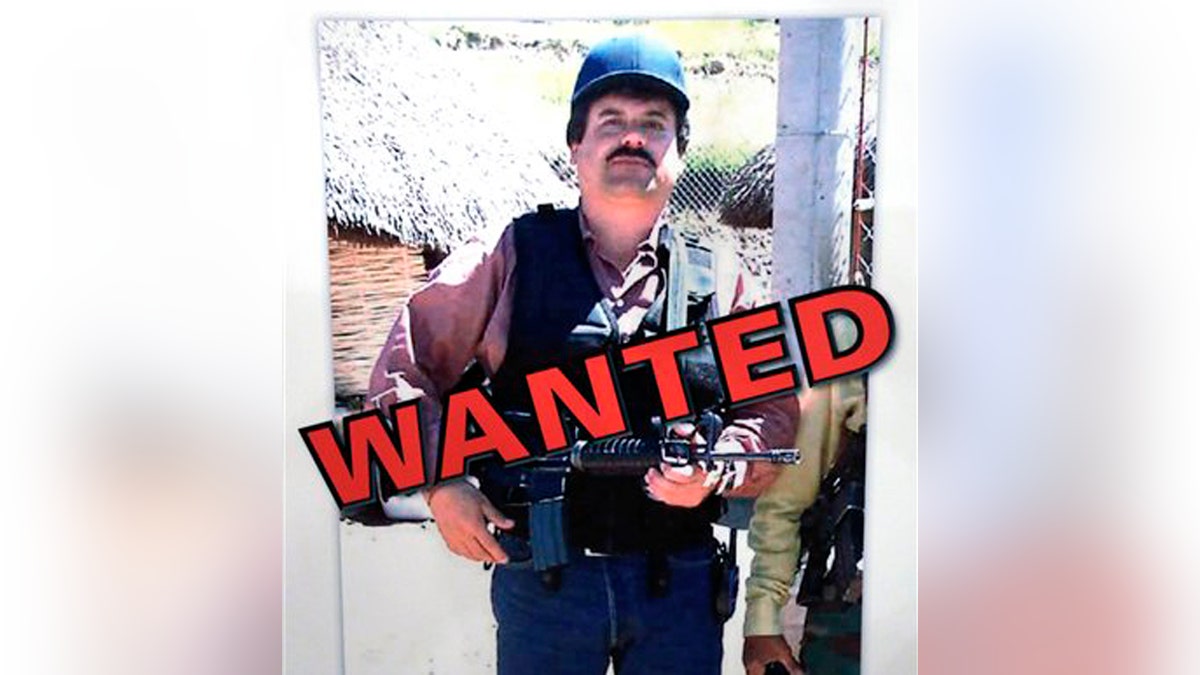
FILE - In a Thursday, Feb. 14, 2013, file photo, a poster displayed at a Chicago Crime Commission news conference in Chicago, shows Joaquin ``El Chapo'' Guzman, who was deemed Chicago's Public Enemy No. 1. In a scheme befitting a caper movie, Mexico's most powerful drug lord, Joaquin "El Chapo" Guzman, escaped late Saturday July 11, 2015 from a maximum security prison through a 1.5-kilometer (1 mile) tunnel from a small opening in the shower area of his cell, the country's top security official announced. (AP Photo/M. Spencer Green, File) ((AP Photo/M. Spencer Green, File))
One by one over the last three years or so, Mexico's most feared drug cartels have splintered, shattered and disintegrated under constant pressure from the country's armed forces, brutal infighting and battles over control of the lucrative trafficking corridors to the U.S.
The Zetas – once deemed one of the most powerful and violent drug trafficking organizations in the country – is a shell of its former self and struggling in a bloody war of attrition with a splinter of the Gulf Cartel along Mexico's eastern coast. Both the Tijuana and Juárez cartels, among the oldest drug syndicates in Mexico, have been beaten down after years of battles along the U.S.-Mexico border.
The death or arrest of numerous high-ranking capos have left the quasi-religious La Familia Michoacana in a state verging on non-existence.
There is one cartel which has not only survived, even after its leader got put behind bars, but thrived during this turbulent time: Joaquín "El Chapo" Guzmán's Sinaloa Cartel.
"What is so striking is how little of a shake-up the arrest of Guzmán had on the Sinaloa Cartel," Christopher Wilson, deputy director of the Mexico Institute at the Woodrow Wilson Center, told Fox News Latino. "They've created a business structure that has allowed them to thrive and survive in ways that others have not."
That business model is based on a loose arrangement of associates. Guzmán and Ismael "El Mayo" Zambada García are in control of the overall organization, but the cartel members beneath them have greater autonomy when it comes to the daily operations of their trafficking corridors and so-called "plazas."
They give the people in charge of each corridor a lot of leeway...It's run like a franchise where everyone gets a lot of autonomy.
When Guzmán was arrested in February of 2014 there was speculation that Zambada would make a play to take over the entire cartel, and that that would lead the cartel to self-destruct due to infighting. That, however, did not come close to happening.
Experts suggest that Zambada's role in the cartel is more of a partner than an underling to Guzmán, and that El Chapo was still very much in contact with his former associates while imprisoned – as evidenced by the elaborate tunnel through which he escaped.
"Even though physically removed [Guzmán] retained a leadership role through consistent communication while in prison, down to planning his escape," Shannon O'Neil, a senior fellow at the Council of Foreign Relations, told FNL in an email.
Unlike other cartels who have employed a similar model – the Zetas, for example – Sinaloa has been able to run its organization with less internal disruptions given that they have focused exclusively on drug trafficking and have remained profitable in that enterprise, experts say.
"They give the people in charge of each corridor a lot of leeway," Adam Isacson, senior associate at the Washington Office on Latin America, told FNL. "It's run like a franchise, where everyone gets a lot of autonomy."
As a rule, the Sinaoloa Cartel has had less violent internal workings than other cartels, but it is by no means peaceable. It has waged bloody wars against the Tijuana and Juárez cartels for control of border towns and supply corridors.
But once victorious, the cartel generally cuts back on the violence. Unlike the Zetas and the Knights Templar, the Sinaloa Cartel prefer to pay off local officials rather than intimidate them – a method that has worked well to keep Mexican authorities out of the cartel's business. And the money has led to less heat from authorities and, as well, something like good will among the general population.
The Sinaloa Cartel is widely considered the wealthiest criminal organization in Mexico, and Guzmán and Co. have used that wealth to buy influence throughout the country's institutions, leading to widespread speculation that the government treats the group with kid gloves.
"It's like the term ‘plata y plomo' or ‘silver and lead,'" Wilson said. "The Sinaloa Cartel focuses more on the silver, while the Zetas focused more on the lead, and that's part of the reason why the Mexican government went after the Zetas."
Guzmán's organization has also employed this tactic in dealing with cartels they have conquered, particularly the Tijuana and Juárez organizations, which they allowed to operate on their old turf as long as they pay tribute or act as intermediaries for the Sinaloa Cartel. This largesse not only keeps money flowing into the cartel, it also helps keep a steady supply of drugs coming into the U.S.
"This ‘Pax Mafioso' is a very desirable thing to Mexican politicians and traffickers alike," Isacson said. "There has been a lot of talk about Tijuana and Juárez being much safer, but ask Border Patrol agents and they'll tell you that as many, if not more, drugs are coming across the border in those locations."
There isn't much reason to expect any of this to change any time soon.
"The Sinaloa cartel has always had a relentless focus on the bottom line and the bottom line is good in the drug business," Wilson said.
